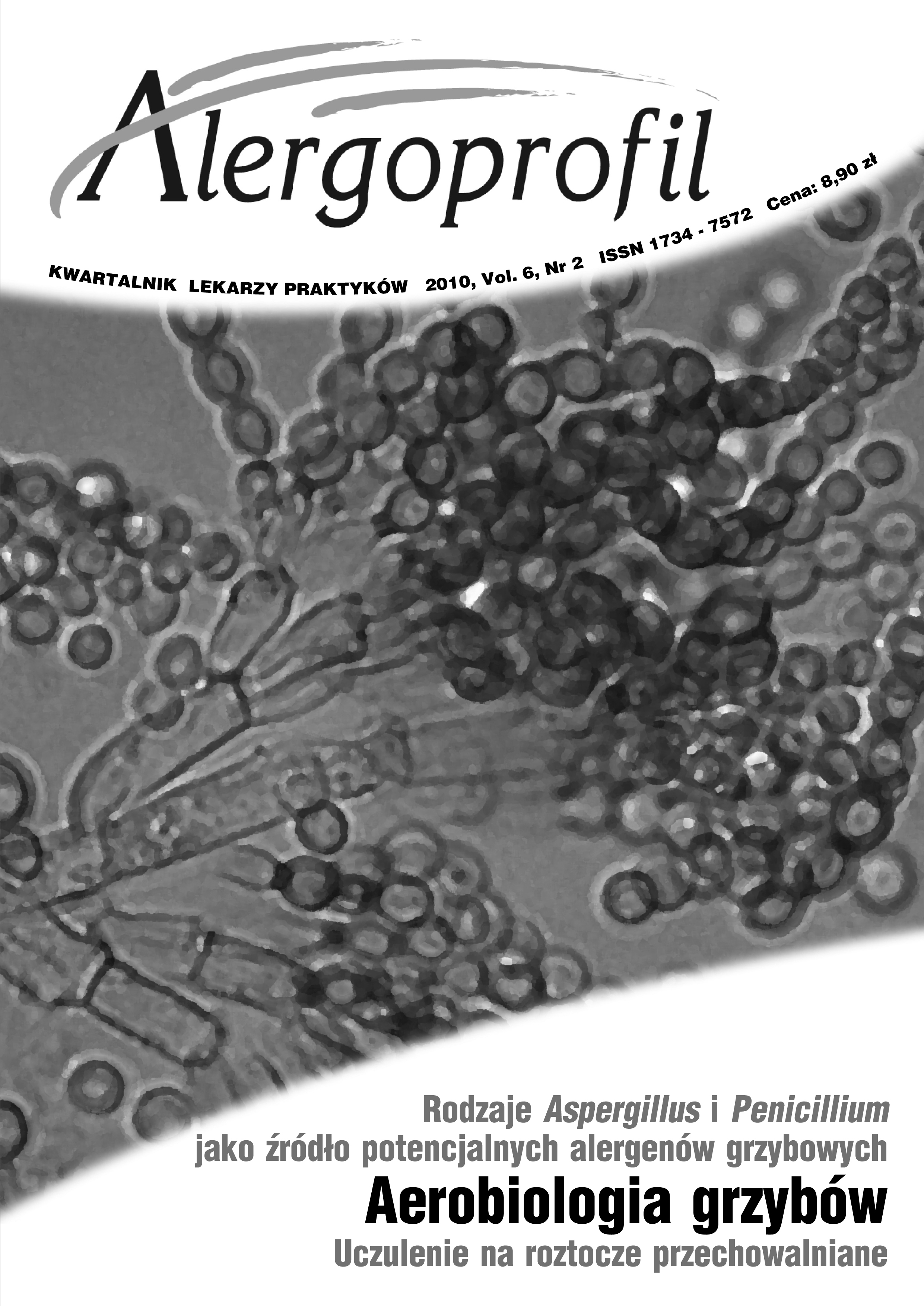Sensitization to storage mites (Lepidoglyphus destructor and Tyrophagus putrescentiae) in a group of bird breeders
Main Article Content
Abstract
Mite make part of natural environment by taking part in a process of metabolism. Bird breeders constitute a group of occupational risk to occurrence of reaction with allergens of mite, specially storage ones. This work was aimed to determine a level of sensitization to particular protein fractions Lepidoglyphus destructor and Tyrophagus putrescentiae in a group of 12 bird breeders. In the group of 12 people, over 30% shown a positive reaction to all determined protein fractions and only 2 persons have not shown allergy to any of determined fractions T. putrescentiae, appropriately less then 20% and 1 person for L. destructor. Average quantity of allergens causing allergy of a single worker amounts to 4 and oscillates from 0 to 6 for T. putrescentiae, from 0–6 with average above 3 for L. destructor. The T. putrescentiae antigen which makes allergic most often is 32,5 kDa (over 80%), next 78 kDa and 18,4 kDa (each 75% equally), for L. destructor 78 kDa and 18,4 kDa equally for 75%. Among breeders allergic to T. putrescentiae antigen 32,5 kDa, for 90% synchronous occurrence of sensitization to fraction 78 kDa has been stated and with the same frequency for 18,4 kDa. Simultaneously frequency of sensitization to L. destructor protein fractions 78 kDa and 18,4 kDa has been state for almost 80% of allergic persons. The survey showed for bird breeders a big risk of exposure to storage mite allergens.
Downloads
Article Details
Copyright: © Medical Education sp. z o.o. This is an Open Access article distributed under the terms of the Attribution-NonCommercial 4.0 International (CC BY-NC 4.0). License (https://creativecommons.org/licenses/by-nc/4.0/), allowing third parties to copy and redistribute the material in any medium or format and to remix, transform, and build upon the material, provided the original work is properly cited and states its license.
Address reprint requests to: Medical Education, Marcin Kuźma (marcin.kuzma@mededu.pl)
References
2. Jeebhay M.F., Baatjies R., Lopata A.L.: Environmental determinants of work-related asthma symptoms on table grape farms-indoor domestic mites or outdoor spider mites? Current Allergy and Clinical Immunology 2003 August, 16 (3): 98-100.
3. Musken H., Franz J.T., Wahl R., Paap A., Cromwell O., Masuch G., Bergmann K.C.: Sensitization to different mite species in german farmers: in-vitro analysis. Journal of Investigational Allergology and Clinical Immunology 2003, 13 (1): 26-45.
4. Revsbech P., Dueholm M.: Storage mite allergy among bakers. Allergy 1990, 45: 204-208.
5. Koistinen T., Ruoppi P., Putus T., Pennanen S., Harju A., Nuutinen J.: Occupational sensitization to storage mites in the personnel of a water-damaged grocery store. Int. Arch. Occup. Environ. Health 2006, 79 (7): 602-606.
6. Solarz K., Szilman P., Szilman E.: Occupational exposure to allergenic mites In a Polish zoo. Ann. Agric. Environ. Med. 2004, 11 (1): 27-33.
7. Solarz K.: Risk of exposure to house dust pyroglyphid mites in Poland. Ann. Agric. Environ. Med. 2001, 8 (1): 11-24.
8. Edston E., van Hage-Hamsten M.: Death in anaphylaxis in a man with house dust mite allergy. Int. J. Legal. Med. 2003, 117 (5): 299-301.
9. Raukas-Kivioja A., Raukas E., Loit H.M., Kiviloog J., Ronmark E., Karsson K., Lundback B.: Allergic sensitization among adults in Tallinn, Estonia. Clin. Exp. Allergy 2003, 33: 1342-1348.
10. Szilman E., Szilman P., Solarz K., Brewczyński P., Sieroń A.L.: Sensitization to the storage mite Tyrophagus putrescientiae in urban population of Upper Silesia (Poland). Wiadomości Parazytologiczne 2004, 50 (3): 471-476.
11. Collof M., Merret T., Merret J., McSharry C., Boyd G.: Feather mites are potentially an important source of allergens for pigeon and budgerigar keepers. Clin. Exp. Allergy 1997 Jan, 27 (1): 60-7.
12. Storaas T., Steinsvag S.K., Florvaag E., Irgens A., Aasen T.B.: Occupational rhinitis diagnostic criteria, relation to lower airway symptoms and IgE sensitization in bakery workers. Acta Oto-Laryngologica 2005, 125: 1211-1217.
13. Walusiak J., Krawczyk-Adamus P., Hanke W., Witczak T., Pałczyński C.: Small nonspecialized forming as a protective factor against immediate-type occupational respiratory allergy? Allergy 2004, 59: 1294-1300.
14. Śpiewak R.: Przyczyny zawodowych chorób skóry u rolników inne niż środki ochrony roślin. W: Ryzyko zdrowotne stosowania pestycydów – problemy teoretyczne i praktyczne. TośLuty S. (red.). Instytut Medycyny Wsi, Lublin 2001: 65-75.
15. Arlian L.G., Morgan M.S., Petersom K.T.: House dust and storage mite extracts influence skin keratinocyte and fibroblast function. Int. Arch. Allergy Immunol. 2008, 145 (1): 33-42.

